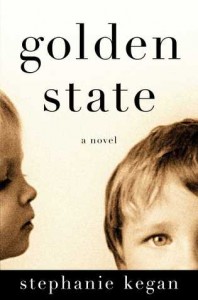Here’s another in our series of reviews by students in the opinion writing class at UNC Chapel Hill’s School of Media and Journalism.
Reviewed by Bradley Saacks
GOLDEN STATE. By Stephanie Kegan. Simon & Schuster. 288 pages. $24.99.
 The fragility of life is a much more subtle universal fear than the always-present worry that we could drop dead at any moment. But the uncomfortable fact that we are subject to whatever random occurrences the universe throws at us destroys the illusion that we are autonomous — a value society idolizes. Despite the overwhelming number of insurance packages and savings accounts available to the modern consumer, there is the chance our lives could be left irreparably damaged by something completely out of our control.
The fragility of life is a much more subtle universal fear than the always-present worry that we could drop dead at any moment. But the uncomfortable fact that we are subject to whatever random occurrences the universe throws at us destroys the illusion that we are autonomous — a value society idolizes. Despite the overwhelming number of insurance packages and savings accounts available to the modern consumer, there is the chance our lives could be left irreparably damaged by something completely out of our control.
A book billed as a drama about the limits of a family’s bond, Stephanie Kegan’s Golden State is much more intriguing as a case study on this phenomenon of an individual’s inability to control the uncontrollable.
Golden State, Kegan’s second book, is told from the eyes of Natalie Askedahl, a middle-age elementary school teacher with a successful lawyer husband and two intelligent daughters. This is the quintessential American family: charmingly old Berkeley home, educated parents and ambitious children. Natalie did everything, by society’s standards, but she still cannot stop the unraveling of her life initiated by an event she cannot escape.
After a slow start, Golden State’s overriding conflict takes hold and dominates: Natalie’s brother, Bobby, has been arrested and charged with bombing several University of California professors and deans after Natalie told the FBI she suspected he might be the perpetrator. Despite Natalie’s best effort to insulate her family from the media circus and personal attacks, her life slowly slips out of her control.
An event of this magnitude affects every aspect of Natalie’s life, as one could have predicted, and Kegan induces the reader to think long and hard about how exactly each aftershock affects Natalie’s life and why it plays out in the manner it does. Specifically, the crisis stretches the limits of her marriage, as she and her husband battle to decide whether their children should be protected or informed. Kegan describes in vivid detail how the normal ebb and flow of a family’s life can be sent spiraling, allowing a reader to empathize with Natalie. This is the book’s most redeeming quality: the forced introspection about one’s own family dynamics and interpersonal relationships.
The story is both predictable and interesting. Kegan’s voice presents her perspective on the world; issues arise that are the worries of only the white and educated upper-middle class. (Despite living in one of California’s most expensive neighborhoods, Natalie quits her job teaching at a private school because her husband’s salary can more than make up for the lost income.) Even Kegan’s — and by extension, Natalie’s — vernacular, which ranges from insightfully educated to unnecessarily opaque, sets a limit on who could read her novel. Despite this, Kegan does well diving into the subplots that surround this critical juncture in Natalie’s life.
And while this book has its flaws — the ending is abrupt and leaves more than one loose end— the positives outweigh them. Kegan took a thought-provoking idea and made it into a novel capable of invoking an emotional response from readers who identify with Natalie’s family life. Taking a more holistic approach when reading this, a reader can enjoy both the superficiality of the story itself as well as the underlying, yet overwhelming, truth that we are ultimately powerless.